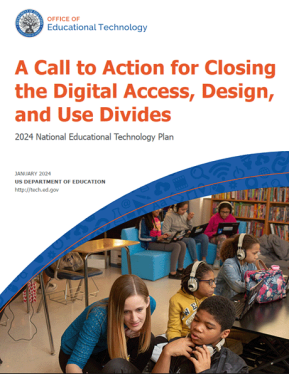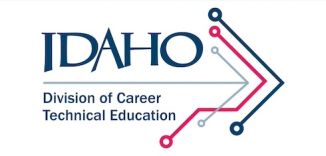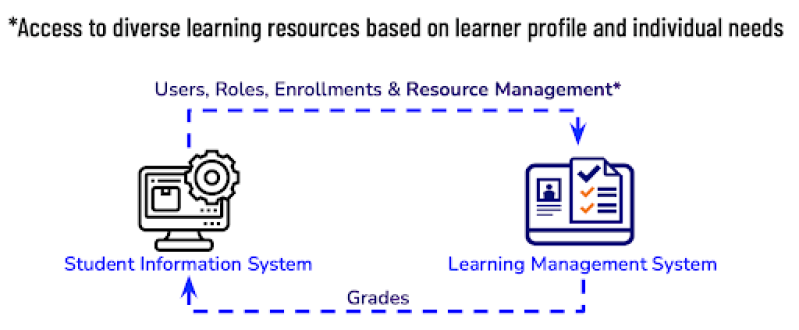
1EdTech commends the U.S. Department of Education for unveiling the 2024 National Educational Technology Plan (NETP), emphasizing the imperative to bridge digital divides for learners and educators alike. We extend our appreciation to the State Education Technology Directors Association (SETDA), a key partner, for their leadership in crafting this report. Thanks to all the contributors involved!

|
|
The last version of the NETP focused on K-12 and was released in 2016, accompanied by the higher education supplement in 2017. It's crucial to recognize that the NETP is more of a "vision" than a strict "plan." In fact, a review of the 2016 edition reveals strategies and technologies, like interoperability, student privacy, and optimizing digital assessment, that continue to challenge K-12 education even after eight years. However, since the last edition, the pandemic has dramatically accelerated experiences in areas like online learning for students, teachers, and parents alike.
Raising the Bar
Given the rise in the use of digital and online learning during the pandemic, it is very appropriate for the 2024 NETP to raise the bar considerably in terms of the expectations for the use of technology to improve education.
To accomplish this, the NETP uses the framework of three related "digital divides" that must be conquered:
- The "Digital Use Divide" is about how technology can be used. It can be used to disseminate learning resources that do not promote active learning. Or, it can be used to create active learning that hopes to stimulate student agency (something we've talked about in 1EdTech over the years as a key to next-generation learning).
- The "Digital Design Divide" is about the strategies and techniques that teachers use in leveraging digital technology. Are they getting the professional learning needed to conquer the digital use divide?
- The "Digital Access Divide" is about access and equity, where, most importantly, equity does not mean access to the same resources but rather to relevant resources that inspire learning.
This is a powerful set of lenses for educational leaders, product suppliers, and philanthropic funders to evaluate learning experiences and the capabilities of the edtech ecosystem. One of the things that I love about the 2024 NETP is the Appendices D-G, which provide brief guides on how to address the three divides for state leaders, district leaders, school leaders, and educators.
Thank You, 1EdTech Member Organizations, for Helping Lead the Way
Typically, reports like this one contain numerous links to examples of state and school district initiatives aimed at addressing educational gaps. While these examples are thought-provoking, they generally lack the systemic improvement seen among 1EdTech members who have embraced an open, trusted, and innovative edtech ecosystem built on open interoperability standards. NETP 2024 highlights two notable examples from the 1EdTech community, characterized by their systemic impact, attributed to leaders' commitment to scaling innovations through the mandated use of open standards at the foundational level.
 The South Carolina Department of Education Instruction Hub enables the state to lift up all the districts in terms of access to a rich collection of digital resources and applications (see page 98 of the report). While many states have implemented some form of a learning object repository (LOR) over the years, they have not been able to be easily integrated into the district-level systems and thus have not been easy for districts to use. South Carolina, like many 1EdTech K-12 members, has established a foundation based on leveraging the widely used open standards from 1EdTech (OneRoster®, LTI™, Common Cartridge®, CASE®, TrustEd Apps™) for digital resource searching/launch, alignment to official state learning standards and providing student data privacy information on the resources.
The South Carolina Department of Education Instruction Hub enables the state to lift up all the districts in terms of access to a rich collection of digital resources and applications (see page 98 of the report). While many states have implemented some form of a learning object repository (LOR) over the years, they have not been able to be easily integrated into the district-level systems and thus have not been easy for districts to use. South Carolina, like many 1EdTech K-12 members, has established a foundation based on leveraging the widely used open standards from 1EdTech (OneRoster®, LTI™, Common Cartridge®, CASE®, TrustEd Apps™) for digital resource searching/launch, alignment to official state learning standards and providing student data privacy information on the resources.
 The Idaho Division of Career and Technical Education (CTE) is not just helping to support the implementation of master-based assessment via the Idaho Math Initiative of the Idaho Department of Education (see page 97 of the report) but has also leveraged the 1EdTech Open Badges standard to ensure that the digital credentials issued are high quality, can be curated by the learner, and can be used across a growing ecosystem of Open Badges platforms and networks across K-12, HED, and corporate learning. Putting in place the open standards foundation greatly increases the value of the credential to the learner over their lifetime. It helps ensure that the state's efforts are not locked into a single platform provider or a limited product-provider ecosystem.
The Idaho Division of Career and Technical Education (CTE) is not just helping to support the implementation of master-based assessment via the Idaho Math Initiative of the Idaho Department of Education (see page 97 of the report) but has also leveraged the 1EdTech Open Badges standard to ensure that the digital credentials issued are high quality, can be curated by the learner, and can be used across a growing ecosystem of Open Badges platforms and networks across K-12, HED, and corporate learning. Putting in place the open standards foundation greatly increases the value of the credential to the learner over their lifetime. It helps ensure that the state's efforts are not locked into a single platform provider or a limited product-provider ecosystem.
For decades in edtech, we have talked about how to enable systemic advancements. It is clear to the 1000-plus member organizations in 1EdTech that widely adopted open standards reduce the cost and time to innovate at scale. This may be why the NETP covered interoperability standards in great depth in the 2016 edition. While our standards have been adopted exponentially since then, much work remains to get interoperability to the level required to meet the vision laid out in NETP 2024.
The Growing Importance of Universal Design for Learning
Universal Design for Learning (UDL) holds a prominent position in the NETP as a key facilitator addressing all three divides. For those unfamiliar, UDL represents a "next-generation" instructional design approach, expanding use cases to drive requirements for diverse means of content representation, learner expression, and engagement, catering to the needs of all learners. UDL is closely tied to accessibility, emphasizing product capabilities to be usable by a wide range of learners.
At 1EdTech, our focus revolves around building UDL and accessibility into the edtech ecosystem. While the conventional approach might be to make each product individually accessible, our emphasis lies in enabling the exchange of information within the ecosystem to facilitate accessibility. Consider the hindrance to innovation if every supplier and institution had to navigate the complexities of ensuring UDL and accessibility preferences are re-entered for each product. Open interoperability standards serve as an efficient foundation, allowing apps to incorporate this information and more seamlessly.

1EdTech's groundbreaking AccessforAll Standard® established an open standard for exchanging personal needs and preferences that has been leveraged by W3C and ISO/IEC over the years. AccessforAll enables ecosystem products to exchange information on the personal needs and preferences of every user. This information can be stored in one place and accessed by all learning platforms, apps, etc. As you might imagine, UDL and accessibility are especially important in creating fair assessments in education. The AccessforAll concept has been carried forward into 1EdTech's digital assessment work, including the latest breakthrough for the assessment community, Question and Test Interoperability (QTI)® 3.0. QTI® is one of the most widely used 1EdTech standards, powering millions of assessment item interactions provided by state and national-level testing platforms.
The leading organization focused on Universal Design across all levels of education is CAST, a close 1EdTech collaborator. CAST has been one of the leading organizations that contributed to 1EdTech's recently published TrustEd Apps™Accessibility Rubric, part of the suite of vetting and self-assessment tools under the 1EdTech TrustEd Apps program.

1EdTech is very appreciative of CAST and the many 1EdTech members in K-12 and HED who contributed to the Accessibility Rubric and approved it as a community-owned standard that we will continue to evolve into the future based on feedback from the market. A big shout out to Instructure for being the first supplier to self-assess against the rubric!
Closing the Divides
Working in the education sector can be frustrating due to the often slow pace of transformative change. At 1EdTech, we express our gratitude to the U.S. Department of Education for their investment in the NETP, providing a robust vision for the future. I also want to highlight the strengths within the education sector, particularly the ability to collaborate and shape the future—an aspect we witness daily at 1EdTech.
Facilitating this collaboration are numerous non-profit associations that sector leaders can draw upon for inspiration and learning. The NETP 2024 serves as a source of inspiration for us all, encouraging us to unite and harness the potential of all learners for the future.
About the Author
Rob Abel, Ed.D.
Dr. Rob Abel is the Chief Executive Officer of 1EdTech, a non-profit collaboration of the world's leading universities, school districts, government organizations, content providers, and technology suppliers, cooperating to accelerate learning technology interoperability, adoption, and impact. Rob has been the CEO of 1EdTech (formerly IMS Global Learning Consortium) since February 2006.
Rob is a recognized expert on the use of information and communication technology (ICT) for learning, with over 40 years of high-tech and education market development experience. During Rob's tenure, 1EdTech has experienced dramatic membership and revenue growth and achieved significant adoption of 1EdTech work by leading regional education communities worldwide. 1EdTech has grown over 20x since Rob became CEO and has become one of the world's best-resourced and dynamic standards-setting consortia.
